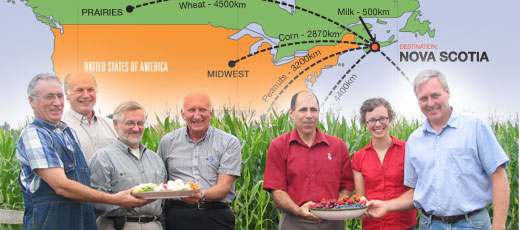
Food Miles Project
Reduced Food Miles Brings Benefits
Are we eating too many foods imported from all over the world? Preliminary estimates show that only about 8.4% of our diet is produced on NS farms. Fifteen years ago it was closer to 15%.
‘Food miles’ are the distance a food item travels from farm to plate. As the distance between our food producers and consumers increases, so can greenhouse gas emissions, rural unemployment, and food insecurity.
Consumers spend less for their food than ever before, while at the same time primary producers continue to get a smaller and smaller share of the food dollar. For some time farm organizations have been arguing that promoting the consumption of local food is one way the primary producer can capture a greater share of the consumer’s food dollar. The arguments have been couched in terms of strengthening the local economy by keeping dollars in the community, enhancing the ability of producer reinvestment in the community – generally that buying local is good for the local economy, good for family farms, good for the environment and good for the health of Nova Scotians; however, these arguments have been primarily based on anecdotal evidence.
For example: We know that high end food products are exported and replaced by imported product, but, we don’t know the extent. We suspect that up to 90% of the food Nova Scotians consume may brought into the province primarily by road transport; however, we don’t know the exact amounts. We suspect that importing an increasingly high percentage of the food we consume has social, environmental and economic costs that impact, not only on farm businesses and the province’s agricultural economy, but on all Nova Scotians as well.

Industry Representatives, Ecology Action Centre, and government officials joined NSFA for the launch of a three year Food Miles project, funded by AAFC. The launch took place at Noggins Corner Farm Market in Greenwich, N.S. This project will study the distance that food travels and the social, economic and environmental impact on the local economy. The Viewpoint on page 2 discusses more on food files.
Shown in the photo from left to right: Andrew Bishop, owner of Noggins Corner Farm Market; Frazer Hunter, President of the Nova Scotia Federation of Agriculture; Eric Frank, Organic Growers Association; Fred Whalen, Warden for Kings; David Morse, Minister of Natural Resources and MLA for Kings South; Marla MacLeod, Food Miles Project Coordinator with the Ecology Action Centre; and Alan Stewart, Wolfville Farmers Market.
We believe that a move from traditional commodity markets to selling a product that consumers can identify with is a critical part of the industry’s survival in the future. We also believe that consumer attitudes are changing with respect to their food choices. Growing concerns regarding food safety and quality, nutrition and environmental sustainability, are increasingly pushing consumers toward local food. This project is a key part of the Federation’s response to the changes noted above. The information generated by this project will provide the farm community with the tools it needs to influence consumer purchasing patterns and promote policy initiatives that will support local production and processing, followed by consumption.[/vc_column_text][/vc_column][/vc_row][vc_row][vc_column width=”1/1″][vc_accordion][vc_accordion_tab title=”Objectives” tab_id=”1522170074-1-69″][vc_column_text]Generally the goal of the project is to define the concept of ‘food miles’ and operationalize the concept in a Nova Scotia context. Specific objectives related to that goal include:
- Development of an annotated data base of related initiatives in other jurisdictions;
- Develop information related to the origin of food consumed in Nova Scotia;
- Develop information related to energy consumption related to imported food;
- Research the economic, social and environmental impacts of importing food;
- Research the barriers related to getting more local food in grocery stores, restaurants, and public institutions;
- The development and testing of educational materials related to the promotion of increased consumption of local food;
- Communication of research results to the general public, and;
- Development and advocacy of related policy initiatives.
Food Dollars Leaving Province
Preliminary estimates show that over time, a smaller share of our food dollars are finding their way back to Nova Scotia farms.

Percentage Of Imported Foods Increasing In Canada, imports of food as a percentage of net supply are going up. For instance, between 1964 and 2001, imports of fruits (and fruit products) have gone from 67% to 97% of supply. Imports of vegetables (and vegetable products) have gone from 20% to 48% in the same time period. While dairy products, poultry, and eggs have remained relatively stable, imports of red meat have risen from 4.2% in 1964 to 24% in 2002 (ref 7).
Project Summary
This report was a collaboration of Ecology Action Centre and the Nova Scotia Federation of Agriculture. Co-authors of the report were Jennifer Scott and Marla MacLeod. Funding for the food miles project was provided through Agriculture and Agri-Food Canada’s Advancing Canadian Agriculture and Agri-Food (ACAAF) Program. In Nova Scotia the program is delivered by Agri-Futures Nova Scotia.


Download:
